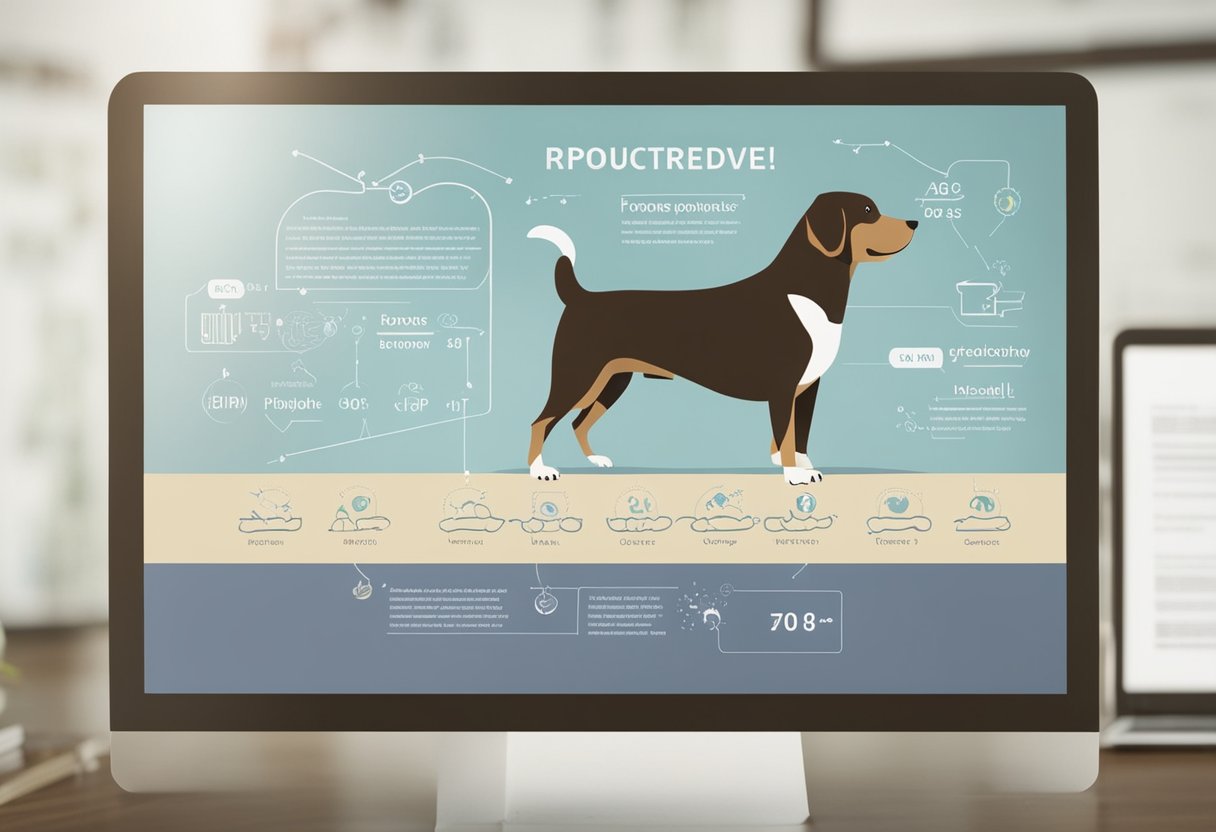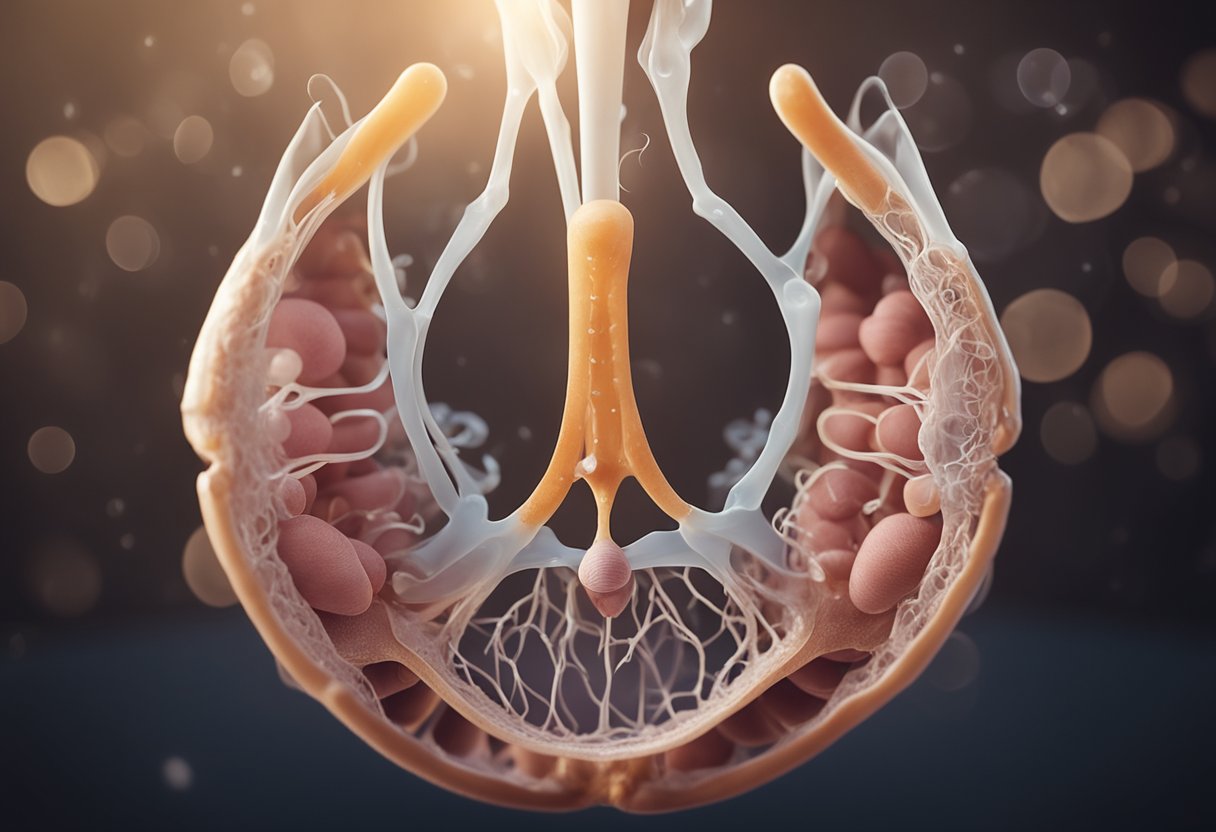Understanding Male Dog Reproductive Health
Fertility and Lifespan
Male dog fertility generally begins at sexual maturity, which can occur as early as 6 months. However, full fertility is often reached when the male is closer to 1-2 years of age, varying by breed. Fertility typically remains robust for much of a male dog’s life but can start to decline with older age. Longevity of fertility is influenced by overall health, genetics, and care including nutrition.

Health Factors Affecting Sperm Production
Several health issues can affect a dog’s ability to produce viable sperm. Conditions like hormonal imbalances, infection or inflammation of the prostate (prostatitis), and testicular cancer can lead to infertility. Regular veterinary check-ups, including rectal exams, are vital for early detection of reproductive issues.
Anatomical Considerations
The testicles are responsible for sperm production, whereas the prostate contributes to seminal fluid. Any abnormalities in these organs can impact sperm motility and overall semen quality. Neutering, or castration, is a surgical procedure that ceases sperm production entirely, rendering the dog sterile.
Sperm Quality and Aging
As male dogs age, they may experience a natural decline in fertility. Factors such as semen volume, sperm count, and motility may decrease with age. For breeding purposes, it’s essential to have a male dog’s semen evaluated. Conditions like prostatic disease can also manifest with age, further compromising fertility.
Maintaining Optimal Reproductive Health
To support male dog fertility, proper nutrition and health supplements may be beneficial. Keeping the dog in good physical shape supports libido and reproductive capabilities. Regular consultations with a veterinarian can help diagnose and treat any fertility problems or underlying health issues.
By understanding these aspects of canine reproduction, pet owners can better manage the reproductive health of their breeding dogs, ensuring a higher likelihood of successful mating and the wellbeing of male dogs throughout their lives.
The Onset of Fertility in Male Dogs

Understanding when male dogs reach fertility is crucial for breeders and pet owners alike. The onset of fertility is marked by sexual maturity, which can vary based on several factors.
Sexual Maturity and Factors Affecting Onset
Male dogs typically reach sexual maturity between six months to 12 to 15 months of age. Specific timing can differ between breeds and individual dogs. Small breeds often mature faster than larger ones.
- Age: The age when a male dog becomes fertile can depend on its size and breed.
- Species: Although dogs generally follow this pattern, there can be variances among different species within the canine family.
- Behavioral Issues: Some male dogs may exhibit behavioral changes as they approach sexual maturity.
Factors influencing the timing of sexual maturity include genetics, health, and nutrition. Male dogs need a balanced diet and good physical condition to develop properly.
Signs of Sexual Maturity
Male dogs show several signs that indicate they have reached sexual maturity and can produce sperm:
- Interest in Female Dogs: An increased interest in female dogs, especially those in heat.
- Marking Behavior: The tendency to mark territory with urine becomes more pronounced.
- Tie during Mating: Ability to tie, which is the copulatory lock during mating with a female dog.
An observable shift in behavior marks the transition into fertile maturity, such as mounting or persistent interest in females. At this stage, they are physically capable of siring puppies. It’s essential to monitor these signs to manage breeding and prevent unwanted litters.
Patterns of Sperm Production

In understanding the reproductive viability of male dogs, it’s imperative to consider factors such as lifespan and health implications that influence sperm production and quality.
Lifespan of Fertility in Male Dogs
Male dogs typically retain the ability to produce sperm for most of their lives. Sperm count, however, can vary and decrease as they reach senior age, which is generally around 7 years and older for most breeds. While fertility might not cease entirely, the capacity for sperm production does witness a decline.
Changes in Sperm Quality with Age
The quality of sperm, including motility and morphology, tends to diminish as dogs become older. This can reduce their likelihood of successful breeding. Senior dogs may still produce sperm, but factors like reduced motility and the presence of abnormal sperm morphology are more likely to be observed as they age.
Health Effects on Sperm Count and Quality
The overall health of a male dog significantly impacts his sperm count and quality. Conditions such as injury or infections can cause temporary or permanent damage to reproductive capabilities. A healthy lifestyle and prompt treatment for health issues are crucial for maintaining fertility in male dogs.
Breeding Considerations

When it comes to male dogs and their fertility, various factors influence their capacity to successfully sire litters. For breeders, understanding these elements is crucial to optimizing breeding outcomes and ensuring the health of both stud dogs and offspring.
Optimal Age for Breeding
Male dogs typically reach sexual maturity around six to twelve months of age, but this varies depending on breed size, with smaller breeds often maturing faster. The optimal age for breeding a male dog is generally between two and five years of age, as fertility is at its peak and genetic health conditions are more readily identified by this age.
Breeding Frequency and Success Rates
Frequent breeding can diminish a male dog’s sperm quality and quantity over time. A healthy stud dog can mate multiple times a week, but to maintain optimal sperm quality, breeders might limit breeding sessions to every other day during a female’s ovulation period. Success rates hinge on timing, the health of both dogs, and the frequency of breeding encounters.
Factors Affecting Breeding Potential
Several factors can affect a dog’s breeding potential:
- Age: Beyond the age of seven, sperm production and quality can decline in male dogs, making successful mating less likely.
- Health: Health issues related to fertility can arise in males, like in females where complications can affect pregnancy and litter size.
- Lifestyle: Overweight dogs or those with insufficient exercise can experience reduced fertility.
- Genetics: Some dogs are predisposed to reproductive problems, affecting their ability to produce healthy puppies.
Managing these factors helps ensure that breeding leads to the birth of healthy puppies, and that dogs can mate at appropriate times to optimize litter sizes and minimize health risks associated with pregnancy and giving birth.
End of Fertility and Sterility
Male dogs experience a decline in fertility as they age, with various physical and clinical indicators signaling the approach towards sterility. These indicators are valuable for breeders and pet owners alike to understand the timing and implications of a dog’s reproductive life span.

Physical Indicators of Declining Fertility
As male dogs reach advanced years, often around the age of seven, specific physical indicators suggest a decline in fertility. Senior dogs may exhibit reduced libido and lower energy levels, both of which can impact mating behavior. Additionally, older dogs can develop health issues such as arthritis or tumors, which could impede the physical act of breeding and signal a natural reduction in reproductive ability. Visible signs of discomfort such as pain, fever, or difficulty in movement during what would typically be mating-related activities can also be indicative of decreasing fertility.
Clinical Assessments and Diagnosis
When a decline in fertility is suspected, a veterinarian can perform clinical assessments to diagnose infertility or confirm a dog has become sterile. The evaluation includes semen collection and analysis to check sperm count and motility, which tend to decrease with age. This can be particularly relevant when dealing with an older male dog attempting to breed with older female dogs, as fertility issues can arise from both partners. Some male dogs may also become neutered to intentionally induce sterility, which is a recommended practice for those not intended for breeding and to prevent certain health issues.
Health Issues Affecting Male Fertility
Male dogs, much like other mammals, can experience a range of health issues that adversely affect their fertility. These problems can range from direct complications within the reproductive system to systemic diseases and side effects of medications.
Common Reproductive System Illnesses
Infections like brucellosis and prostatitis are significant contributors to infertility in male dogs, often resulting in reduced sperm count or poor ejaculate quality. These conditions can lead to more severe complications, including swelling and pain in the reproductive organs. Additionally, other forms of cancer, such as testicular cancer, can impede reproductive capabilities by affecting the testes, where sperm production takes place. Regular urinalysis and ultrasound may help detect such abnormalities early.
Impact of Systemic Diseases on Fertility
Systemic diseases, which affect the body as a whole, can indirectly reduce a male dog’s fertility. For example, hypothyroidism can cause hormonal imbalances that may result in diminished libido and decreased sperm production. Such illnesses often require comprehensive management to mitigate their impact on reproductive health. A comprehensive diagnostic approach, including thorough physical examinations, hormone assays, and assessment of overall health, is essential to address systemic diseases that hamper fertility.
Medications Influencing Reproduction
Certain medications can have a toxic effect on sperm production and male fertility. Drugs used to treat a male dog’s non-reproductive illnesses may inadvertently decrease sperm quality or count, hence affecting fertility. It’s crucial for veterinarians to evaluate the risk-to-benefit ratio of any medication regimen in the context of preserving reproductive potential, especially for breeding dogs. Drugs, such as those used for chemotherapy or ones with anti-androgenic properties, are known to have adverse effects on male reproductive health. Therefore, vet-prescribed medications should be monitored for their impact on fertility.
Understanding Neutering and Its Effects
Neutering is a surgical procedure that halts sperm production in male dogs, influencing both their behavior and health. It is an important decision for pet owners to consider in the context of their dog’s well-being.
The Neutering Procedure
Neutering, or castration, is the removal of a male dog’s testicles performed by a veterinarian. This procedure eliminates the dog’s ability to produce sperm and sterilizes him, thus preventing reproduction. Neutering involves making an incision near the scrotum, through which the testicles are removed. Post-operative care is crucial to prevent infection and ensure proper healing. The dog may experience some pain and swelling after the surgery but typically recovers within a few weeks.
Behavioral and Health Outcomes of Neutering
Neutering a male dog can result in a reduction in certain behavioral issues, such as aggressive tendencies, roaming, and marking. It is often associated with a decrease in libido and the urge for copulation. In terms of health, neutering may lower the risk of certain types of cancer, including testicular and perhaps prostate cancer, though the evidence for the latter is not straightforward. Additionally, neutering may prevent the development of benign prostatic hyperplasia (BPH) and certain types of tumors or prostate issues. It’s important to note that while neutering may have several benefits, it does not eliminate the risk of all diseases and should be discussed with a veterinarian for a thorough understanding of potential impacts on a dog’s health.
Managing Older Male Dogs
As male dogs progress into their senior years, they may experience a decline in sperm production along with an increased risk of health issues related to age. It’s essential to adapt their care regimen to maintain their well-being and manage any conditions that arise.
Nutrition and Care for Aging Studs
Senior male dogs require specially formulated nutrition to support their changing bodies. A healthy diet for an aging stud dog should include:
- Increased levels of antioxidants to combat oxidative stress.
- Adequate protein to maintain muscle mass.
- Low-calorie options to prevent obesity, which can exacerbate age-related conditions such as arthritis.
Coordinated with veterinary advice, dietary supplements might be beneficial, especially those designed to support joint health and cognitive function. Regular, gentle exercise should be maintained to support mobility and longevity.
Common Conditions in Senior Male Canines
Senior stud dogs are at risk for several age-related conditions:
- Prostate issues can affect fertility and overall health.
- Cancer, including testicular and prostate tumors, is more prevalent in older male dogs.
Monitoring for signs of illness, such as fever, pain, or changes in bathroom habits, is critical. Early detection of problems such as tumors or injuries can lead to more effective management. Proper care includes regular veterinary checkups to ensure the healthy aging of your stud dog. Conditions like arthritis can be managed with pain relief medications and modifications to the home environment to reduce strain on joints.
Responsible Breeding Practices
Responsible breeding practices encompass strategies to prevent unwanted litters and ensure the genetic health of the canine lineage. Breeders are tasked with understanding the complexities of canine reproduction to avoid health issues and promote the welfare of both the adult dogs and the puppies they produce.
Preventing Unwanted Litters
Preventing unwanted litters is crucial in dog breeding. To achieve this, breeders must understand the reproductive cycle of dogs, particularly knowing when a female dog is in heat as this is the time she can conceive. Neutering males that are not intended for breeding can prevent accidental pregnancies. In female dogs, spaying or careful monitoring during heat cycles can ensure they do not mate unintentionally, especially since small breeds might reach sexual maturity earlier than expected.
Genetic Screening and Health Testing
Genetic screening and health testing are integral parts of responsible breeding. Before breeding, dogs should be tested for hereditary conditions that are common within their breed standards. This helps to reduce the risk of puppies inheriting serious health issues. Moreover, routine health screenings can detect signs of infections or reproductive tract issues that could affect fertility and the successful delivery of a litter. It is also important to avoid inbreeding, which can amplify the risk of genetic disorders.
By adhering to responsible breeding practices, breeders can contribute to the overall health and continuity of breed lines while ensuring the safety and well-being of both adult dogs and puppies.
Frequently Asked Questions
Male dogs’ reproductive capabilities can change as they age, including when they may become too old to sire puppies effectively. This section addresses common inquiries regarding the fertility of aging male dogs.
At what age is a male dog considered too old to sire puppies?
Male dogs can often sire puppies well into old age. However, fertility generally begins to decline once they reach 7 to 10 years old, with variability depending on the individual’s health and breed.
How does aging affect a male dog’s fertility?
As male dogs age, they may experience a decrease in sperm quality and quantity. Testosterone levels typically drop, which can reduce fertility and influence their ability to sire puppies.
What signs indicate a decline in reproductive ability in aging male dogs?
A decline in reproductive ability in aging male dogs can be identified by less frequent successful matings, a decrease in the volume of semen produced, and less active and motile sperm.
What is the maximum age for a male dog to be used for breeding purposes?
There is no definitive maximum age for a male dog to be used for breeding, as it can depend on the individual dog’s health and vitality. However, many breeders choose to retire male dogs from active breeding around 10 years of age.
Is there a difference in breeding capability between older male and female dogs?
Yes, older female dogs typically have more distinct reproductive limitations compared to male dogs, such as irregular heat cycles and reduced litter size, whereas male dogs can often continue to produce sperm well into their senior years.
What are the AKC breeding age requirements for male dogs?
The American Kennel Club (AKC) requires male dogs to be at least 7 months old before they can be registered as sires. The AKC does not set an upper age limit, leaving that to the discretion of the breeder based on the dog’s health and fertility.
